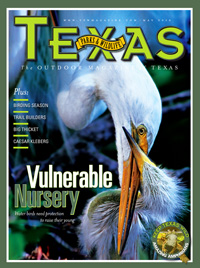
Skill Builder: Turning Kids into Birders
If you lead them in the right direction and make it fun, they may soon know their warblers and waxwings.
By Bernadette Noll
When I was growing up in New Jersey, my family took a fabled summer trip to the Brigantine National Wildlife Sanctuary in the mid-1970s. It was August at the Jersey Shore with record temperatures in the low 100s. My dad and my uncle took 10 or more of us siblings and cousins away from the beach and into the car for a little nature outing — to look at birds and expand our vacationing minds.
Legend has it we saw not one bird all day. At least none that any of us remembered. All we recalled were the mosquitoes, the heat and the non-air-conditioned, overcrowded, faux-wood-paneled station wagon. For the next 20 years or so, when the topic of birding was brought up at any family gathering, it elicited groans from all who had survived that journey.
I tell this tale not to evoke sympathy but to give you one example of how not to get your kids into birding. Torture your kids into your hobby, and they will run screaming in the opposite direction. Make it fun, and you will open their minds up to the possibility of getting hooked. Once they are hooked, or at least not repulsed, they will be birders before they know it.
As the parents of four children, we have learned, sometimes the hard way, that children are born hard-wired. But with the proper care, you can inject them with a little bit of your own likes and build a whole list of shared interests and hobbies. Through trial and lots of error, here are my tips for getting kids into birding.
1. Make it fun. Don’t make it all about the birds but rather about the snacks, the location, the car ride, the time together and the time spent outdoors. Start with a woo-hoo attitude and leave all expectations behind. Enjoy the process, whatever that process may be.
2. Start small. Start in your own backyard. What’s out there? Make a feeder. Keep it filled. Add a water feature. Give them a connection to the birds that are a part of their everyday world. Enjoy the Carolina wren, the cardinal, even the sometimes pesky blue jay. Though these birds are common, watching them and chronicling their behavior will be a great way to build your kids into birders.
3. Give them guidance but don’t pack on the facts. Give them their own field guide and a sketch book. Let them enjoy learning about the birds on their own terms. They don’t need to know every detail, field mark and habit of the birds. Lead them toward information but let them gather it in their own time and way.
4. On outings, declare a family target bird and have each person declare his or her own — something you hope to see for the day. This gives each person a goal and at the same time adds a little friendly competition to it all. This is my husband’s great idea, and it really has proved helpful in getting everyone on board.
5. On any outing, make the birding aspect optional. If you force it, they will flee. Model the birding behavior but let them have their own experience. Want to climb a tree? Sit in the grass? Pick up sticks? And occasionally, if there’s a bird you really want to see, carrying a few gummy bears in your pocket never hurt your cause.
6. Don’t overly shush your kids. Sure, there are times when the outing calls for quiet. But an entire outing of quiet will definitely cause great lack of interest. Birding for warblers might require calm and quiet, but looking for ducks allows you to be as noisy as you’d like. Mix it up a bit.
Our children alternate between calling themselves birders and avidly declaring themselves not. But, as time goes on it’s easier than ever to persuade them to join us in the search. Some of our best family outings have been out in the field looking for birds.

